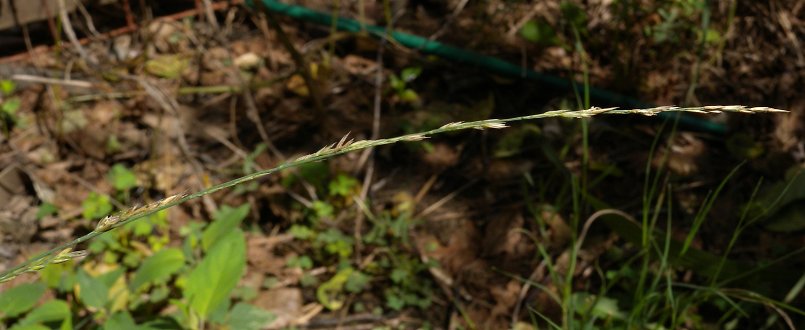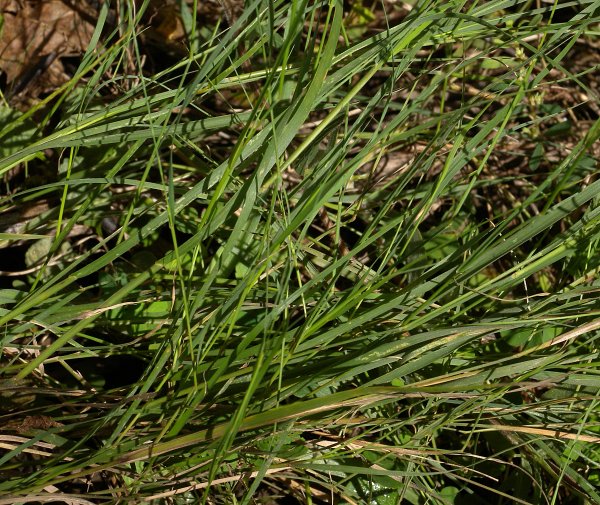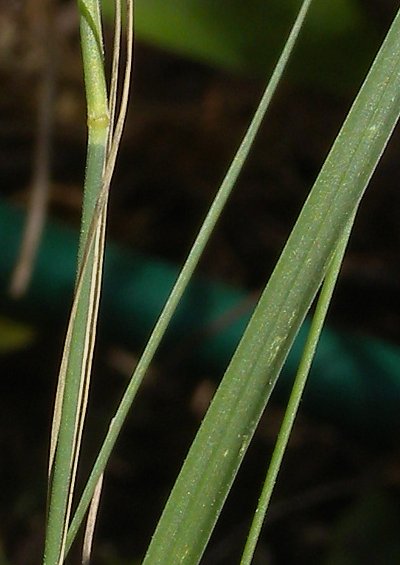
Each fertile culm terminates in a narrow panicle of spikelets about 3-5" long and less than ¼" across; this panicle has a spike-like appearance and it is straight to slightly arching. While immature, the panicle of spikelets is shiny light green, but it later becomes light tan at maturity. Along the rachis (central stalk) of each panicle, there are several secondary branches up to 1¼" long that are erect or appressed. These secondary branches are usually solitary, rather than occurring in whorls of 2 or more. Near the bases of these secondary branches, there are solitary pedicellate spikelets, while one or more pedicellate spikelets occur toward their tips. The pedicels of these spikelets are up to 3 mm. long. The central rachis, secondary branches, and pedicels are light-medium green, slender, and slightly scabrous. Each spikelet is about 3 mm. long, narrowly lanceoloid in shape, and somewhat flattened; it consists of a pair of glumes, a fertile lemma, a palea, and a perfect floret with 2 stigmas and 3 stamens.

The glumes are 1.5–2.5 mm. long, lanceolate in shape, membranous along their margins, and slightly keeled; one glume is slightly longer than the other. The lemma is about 3 mm. long, otherwise it is similar to the glumes. Both the glumes and lemma are glabrous to minutely pubescent. The small stigmas are plumose (feathery) and reddish purple. The blooming period occurs from late summer to early autumn; individual florets remain in bloom for about 1 week. The florets are cross-pollinated by the wind. Afterwards, the fertile florets of spikelets are replaced by grains. These grains are about 2 mm. long, narrowly ellipsoid in shape, light tan, and somewhat flattened; they are light enough to be blown about by the wind to some extent. The root system consists of a crown of fibrous roots.
Cultivation: This grass prefers full sun, dry conditions, and a relatively heavy sterile soil containing clay and/or stony material. It is able to tolerate partial sun and soil that is more moist and fertile, although its leafy culms have a tendency to sprawl under these conditions. Growth and development occur slowly and steadily during the summer, and resistance to drought is good. Prairie Satin Grass could be used as an ornamental grass in rock gardens that are sunny and dry.

Range & Habitat: Prairie Satin Grass occurs in widely scattered areas of NE and western Illinois, where it is native and rare (see Distribution Map). Most populations of this grass within the state have been found relatively recently. Illinois lies along the SE range limit of this grass, which is more common in the northern plains region of the United States and adjacent areas of Canada. In Illinois, habitats include hill prairies, upland gravel prairies, upland dolomite prairies, rocky bluffs, limestone glades, long sloping banks of major rivers, and grassy fens (this last habitat is atypical). In Illinois, Prairie Satin Grass is a conservative species that is found in sunny upland areas where some of the original ground flora remains intact from disturbance (e.g., grazing from cattle).
Faunal Associations: Prairie Satin Grass (Muhlenbergia cuspidata) is the host, or probable host, of several oligophagous or monophagous leafhoppers, including Flexamia imputans, Flexamia serrata, Flexamia stylata, and Lonatura megalopa (Hamilton & Whitcomb, 2010; Whitcomb & Hicks, 1988). However, these leafhoppers are distributed primarily in areas that lie NW of Illinois, where Prairie Satin Grass is more common. Among vertebrate animals, the Wild Turkey feeds on the seeds, while such hoofed mammalian herbivores as the Elk, White-tailed Deer, and domesticated cattle browse on the foliage to a greater or less extent, depending on the geographic location (Fry, 2009).

Photographic Location: The wildflower garden of the webmaster in Urbana, Illinois.
Comments: Prairie Satin Grass (Muhlenbergia cuspidata) has very slender stems and leaves, and its inflorescence is narrow and spike-like. Although it has an appearance that is rather insubstantial and ethereal, this grass is tougher than it looks. Compared to other similar Muhlenbergia spp. (Satin Grasses) in Illinois, Prairie Satin Grass can be distinguished by its somewhat flattened stems, narrow leaf blades (1-2 mm. across), spike-like inflorescence, awnless spikelets, and lack of rhizomes. Like many true prairie grasses, it is a bunchgrass, rather than a sodgrass. The bunchgrass habit is the result of an expanding crown of fibrous roots as this perennial grass ages. Another common name of this grass is Plains Muhly.